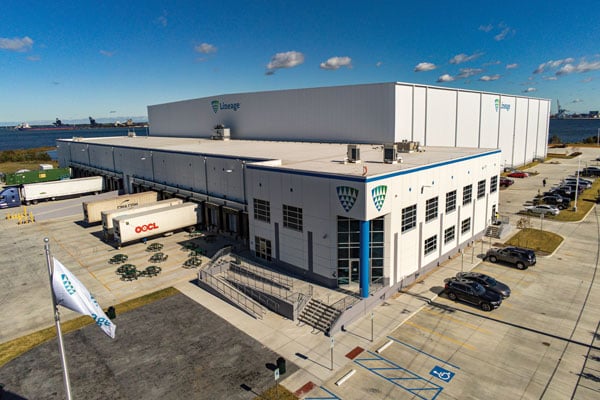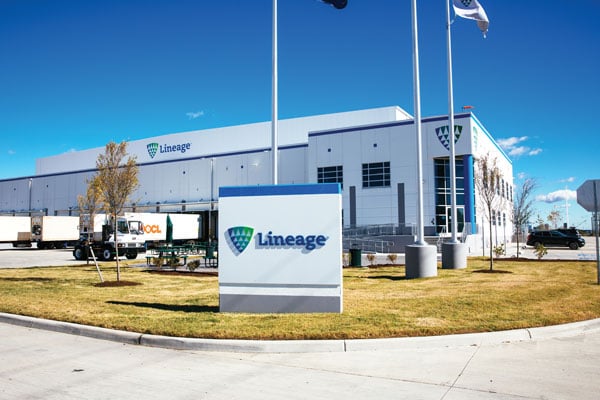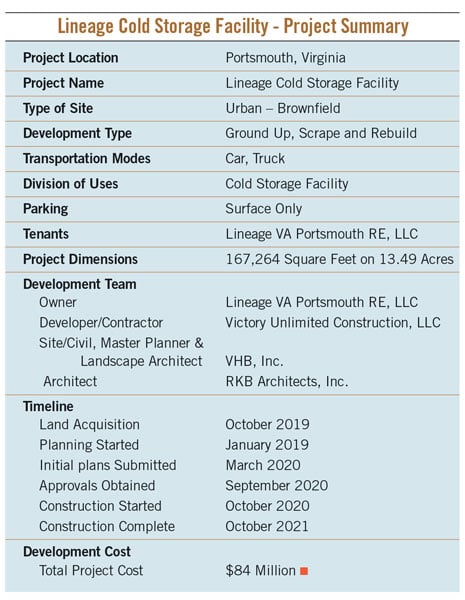Transforming an Abandoned Brownfield into a Modern Cold Storage Facility

A public-private collaboration results in an $84 million investment and more than 80 new jobs in Portsmouth, Virginia.
In October 2021, Lineage Logistics, LLC opened a new cold storage facility in Portsmouth, Virginia, for importing, exporting, processing and distributing a variety of food products across the region. The new facility is helping meet the surge in demand for cold storage space and strengthening the Port of Virginia’s supply chain and logistics infrastructure.
Situated on the Elizabeth River on a former BASF manufacturing site, the cold storage facility’s strategic location gives Lineage access to global markets via the Virginia International Gateway Terminal, which is about 1.5 miles away. The repositioning of this property resulted in an $84 million investment, more than 80 new high-paying jobs and significant economic benefits to the community.
The Cold Storage Industry
Investments in cold storage, warehouse, distribution and delivery facilities are on the rise to meet the demand generated by companies engaged in e-commerce, third-party logistics, packaging supply and the food industry. As consumers across the nation have become more conscious of what they eat, the demand for healthy, fresh food has escalated. As a result, the industry has seen increased demand for cold chain facilities. Refrigerated storage has become an integral part of the transportation and storage of temperature-sensitive products.
The pandemic further accelerated the need for high-quality space. According to Global Trade, North America’s cold chain market reached a value of $88.5 billion in 2019 and is expected to grow to over $142 billion by 2025.
Access to ports and connected transportation networks are critical strategy components for cold storage operators, and businesses are seeking sites that give them access to global markets. Asset repositioning is taking center stage as communities across the nation identify underutilized sites that can be returned to productive use to fulfill the need for high-quality industrial real estate.
Repositioning the BASF Site
For more than a century, manufacturing facilities occupied the Portsmouth waterfront. BASF, a German-based multinational chemical company, established its Portsmouth factory in 1999, where it produced and exported more than five million diapers a year.
In 2007, BASF shuttered the Portsmouth plant and moved its operation to Texas as part of a larger corporate strategy to increase productivity and efficiency by concentrating production at fewer U.S. sites. Once the plant was closed, the chemical giant focused on remediating extensive environmental issues resulting from its work with superabsorbent polymers to return the 44-acre Portsmouth site to productive use. However, volunteer remediation efforts moved slowly, and the site sat dormant for many years.
In 2016, a ship repair and fabrication services company purchased the 44-acre waterfront parcel to support the company’s growth and its ability to efficiently service the shipping industry. Expansion plans included extra capacity for ship repairs for both the U.S. Navy and the private sector, as well as for the construction of new ships. The BASF site seemed ideal with its waterfront access, potential for berthing space, and lift capacity that could accommodate vessels up to 250 feet long, 56 feet wide and 15 feet deep.

The Lineage Logistics facility in Portsmouth, Virginia, has more than 26,000 rack locations and 50 refrigerator container plugs on site. Lineage Logistics
VHB, a civil engineering firm, became involved in 2016 when the site’s new owner engaged the firm to prepare the due diligence, which helped the owner understand the value of the land and the infrastructure investments necessary to support landside and waterside uses. Plans included the development of shipping repair facilities and a new deep-water marine terminal. VHB analyzed the site’s capacity and prepared master development plans that included programming for several new facilities. After investigations, VHB determined that a deep-water marine facility was cost prohibitive. An excessive amount of dredging would be needed, and its subaqueous impacts would make permitting challenging.
In 2018, the site was sold to Marathon Development Group. With its previous site knowledge, VHB was engaged to continue to work on plans for the new owner.
The Hampton Roads area of Virginia was experiencing extremely low industrial vacancy rates, and Marathon recognized the need for additional space. VHB prepared multiple development scenarios, test-fitting several different industrial use types for the property so Marathon could gain a full understanding of its development potential. Site and concept plans were prepared for multiple warehouses, cold storage and cross-dock facilities.
In early 2019, Virginia was competing with Georgia and South Carolina for a large investment from a major cold storage operator. The Virginia Economic Development Partnership began working closely with the city and regional agencies to identify sites that would be suitable for a new cold storage facility.
The city of Portsmouth had long viewed the BASF site as an economic development opportunity. Calls were placed to Marathon Development and VHB, and they began collaborating on test fits and layouts, producing multiple options that would strategically position a new cold storage facility on the Elizabeth River. Just three months later, the former BASF site in Portsmouth was chosen for Lineage Logistics’ (formerly Preferred Freezer) new facility. Lineage is the world’s largest temperature-controlled industrial REIT, and it maintains a network of fully automated cold storage facilities worldwide.
Public–Private Collaboration
Portsmouth Economic Development worked closely with the Virginia Economic Development Partnership (VEDP), the City of Portsmouth, the Hampton Roads Economic Development Alliance and the Virginia Port Authority to attract Lineage to the Portsmouth region and secure the $84 million investment. The public agencies and the site’s owner and engineering firm closed the deal in April 2019, just three months after the initial call.
The city of Portsmouth had laid the groundwork for future industrial activity by creating and adopting a new comprehensive plan in 2018, Build One Portsmouth, which established a long-range plan and vision for development, revitalization and preservation of the city. The plan set the framework and guiding principles for the city’s future, which included economic development through the strategic assembly of vacant and underutilized land to make it available for redevelopment and return it to private ownership.
“The repositioning of the BASF brownfield site demonstrates the power of public-private collaboration,” said Robert Moore, director of economic development with the Portsmouth Economic Development Agency. “City, state and regional agencies collaborated with the site’s owners and the engineering team to present Lineage Logistics with the benefits of developing this new cold storage facility on Portsmouth’s waterfront in an extremely short timeframe.”
In addition, the Port of Virginia has made significant investments in the port’s capacity. Between 2015 and 2025, it will have invested $1.5 billion in infrastructure, creating a network of six terminals that can handle any type of cargo.
The Port of Virginia is centrally located in the Mid-Atlantic, a two-day drive from 75% of the U.S. population. It has direct interstate highway access from all terminals. It is also the largest intermodal rail port on the East Coast, with service to 19 inland destinations. Currently, it is the third-largest container port on the East Coast. The network of terminals can process more than four million containers annually and supports ultra-large container vessels arriving from across the Atlantic.
In 2024, the Port of Virginia aims to be the deepest port on the East Coast with 55-foot channels and two-way traffic for the largest vessels.
State Incentives
Lineage received incentives from the state of Virginia, including a grant from the Commonwealth’s Development Opportunity Fund (COF). The COF is a “deal-closing” fund that can be employed at the governor’s discretion to secure a company location or expansion in Virginia. The COF is administered by the VEDP and serves as a final resource for Virginia in the face of serious competition from other states or countries. COF grants are negotiated amounts determined by the Secretary of Commerce and Trade, based on the recommendation of VEDP, and subject to approval by the governor.
Lineage received $180,000 that was tied to the creation of 60 new jobs over the course of three years. The COF funds were designated for distribution at the end of each year of operation and were earned based on every 20 new jobs created. Lineage exceeded the city of Portsmouth’s goals and created 80 new jobs within the first year of operation, so the project will receive the full amount of funding in the first year.
The Portsmouth Port and Industrial Commission (PPIC) matched this amount with an additional $180,000. In addition, VHB assisted the city of Portsmouth in securing a $600,000 Economic Development Access Program Grant from the Virginia Department of Transportation to convert a paper street — a road that only existed on a map — to a public right-of-way that helped improve access to the site and the new cold storage facility. The former ”Chemical Way” was converted to ”Lineage Way.“
The Real Work Starts
Once Lineage confirmed that Portsmouth would be the home of its new facility, it purchased a portion of the BASF parcel from property owners, Marathon Development. The design team — Victory Unlimited Construction, RKB Architects and VHB — then set to work to deliver the new facility by mid-2019.
Lineage’s new cold storage facility was delivered using alternative delivery or design-build, which focuses on collaboration and innovation to deliver projects in a timely and cost-effective manner.
According to the Design-Build Institute of America, in design-build, “the owner manages only one contract with a single point of responsibility. The designer and contractor work together from the beginning, as a team, providing unified project recommendations to fit the owner’s schedule and budget. Any changes are addressed by the entire team, leading to collaborative problem-solving and innovation.”

Lineage Logistics received several financial incentives from state and local authorities. These included $180,000 for the creation of 60 new jobs and a $600,000 Economic Development Access Program Grant from the Virginia Department of Transportation. Lineage Logistics
Victory has a strong track record delivering cold storage facilities across the nation and a long history with Lineage, and it worked with the team to deliver this new facility under an accelerated schedule. By utilizing design-build, the team was able to mitigate the risks throughout the design and construction process and meet critical timelines as well as the opening-day schedule.
To facilitate an accelerated construction schedule, VHB prepared a plan to handle earthwork, erosion and sediment control, as well as demolition and stormwater containment. This allowed the contractor to start the massive amount of demolition while the final design documents were being prepared.
Also, with the building’s location on the edge of the Elizabeth River, depressed loading docks were not feasible, and the facility had to be constructed four feet higher than existing grade to prevent the loading docks from flooding during major rainfall events, which could stall the distribution of goods. Having the engineer and contractor collaborate from the beginning benefitted the project by reducing risks and improving speed of design and construction.
VHB designed and developed the site using Autodesk Civil 3-D software, a civil engineering tool that saved the team time and money. Because Civil 3-D software is dynamic, a change made in one section of the design affects the entire project, modifies plans in real time and connects the design to the production drawings. Therefore, the team was able to walk through what-if scenarios and make certain that there were no utility conflicts with the domestic water, fire suppression, sanitary sewer, irrigation, gas and storm drainage on a complex site.
Challenges and Hurdles
Although there was strong support for this project, the overall development faced potential regulatory hurdles. VHB worked with the U.S. Army Corps of Engineers to coordinate the stormwater outfall locations that needed to be constructed to support this new facility. The outfalls were designed so they drained above the median high-water elevation of the Elizabeth River, avoiding a lengthy permitting process.

In addition, the site went through the Virginia Department of Environmental Quality’s Volunteer Remediation Program. As a result, the project needed to be monitored throughout construction by a third-party inspector. The previous owners of the site had demolished the buildings down to slabs and foundations, and prior to construction there were health and safety concerns about potential groundwater contamination. In the event groundwater was encountered during construction of the new foundations and/or utilities, a health and safety program with defined protocols was put into place.
In the late stages of the design process, the project design team determined that the project would need to use an existing above-ground 100,000-gallon water tank adjacent to the site to meet the new facility’s fire-protection demands. This meant a complete redesign of the fire protection system on site. VHB completed the advanced water modeling necessary to support the use of the water tank and submitted the plans to the city of Portsmouth for approval. A consultant worked with the team to determine and vet the design of how the tank would function with the overall fire system. VHB and Victory Unlimited Construction prepared an easement exhibit for the use of the tank with the landowner, Marathon Development Group.
A Regional Asset Reclaimed
With more than 26,000 rack locations and 50 refrigerator container plugs on site, Lineage’s new facility will help meet the surge in demand for cold storage space and strengthen the Port of Virginia’s supply chain and logistics infrastructure. The 167,264-square-foot facility increases storage density, maximizes capacity, provides real-time inventory management and keeps food safe while reducing energy consumption. It is an important regional asset that will help increase the volume of cold cargo moving through the Port of Virginia.
As demand soars for high-quality industrial real estate, communities are looking to repurpose underutilized assets for productive use to fulfill the needs of the market. Economic development agencies are busy partnering with communities to identify strategically located sites in key markets and forming coalitions to promote shovel-ready sites that are available for development. Major industrial investments like Lineage Cold Storage generate tax revenue and new jobs and result in economic benefits to residents. In addition, many sites are undergoing extensive remediation to mitigate contaminants, and these cleanup efforts result in healthier, sustainable and resilient communities.
Kenneth E. Rodman, Jr., is the Mid-Atlantic real estate director for VHB.




